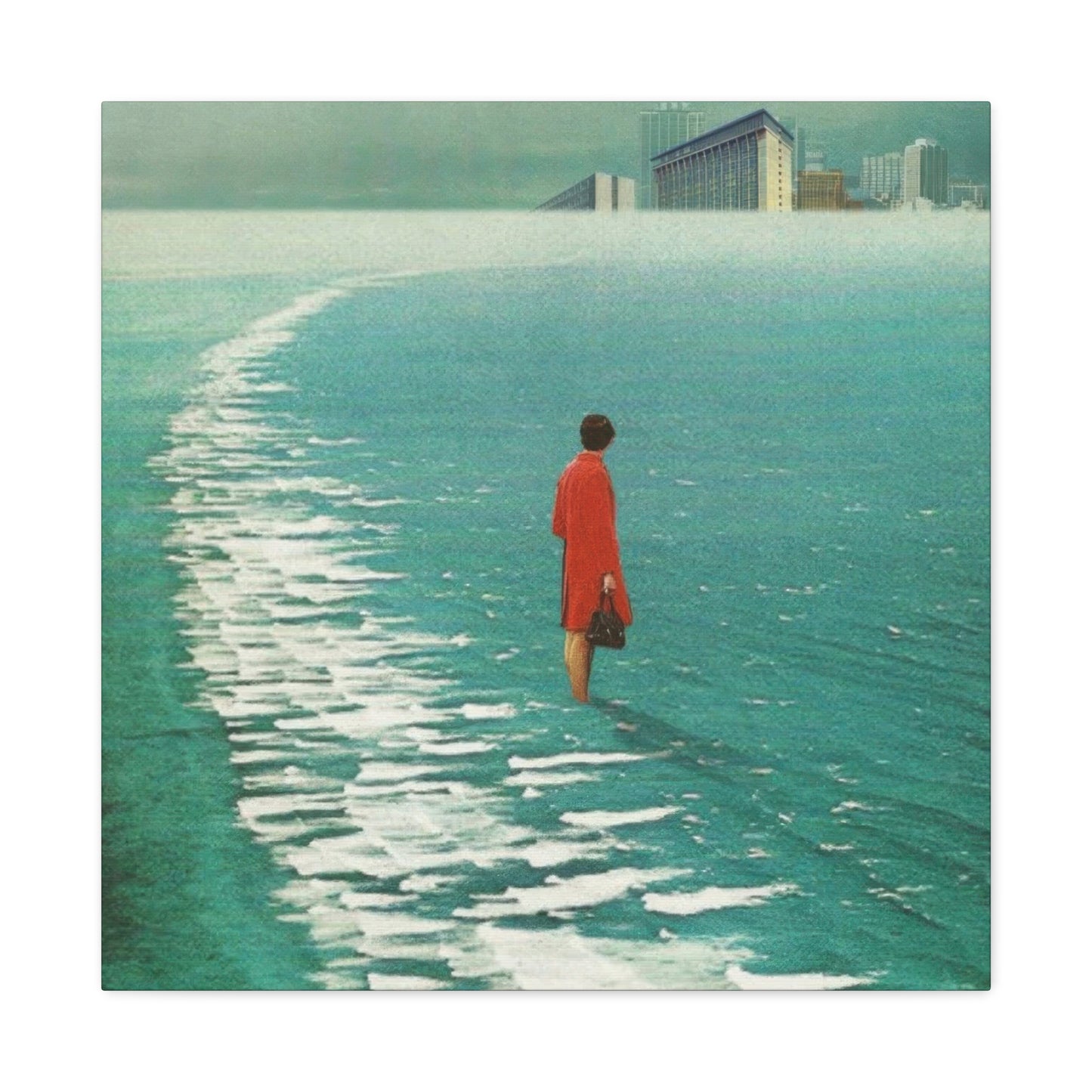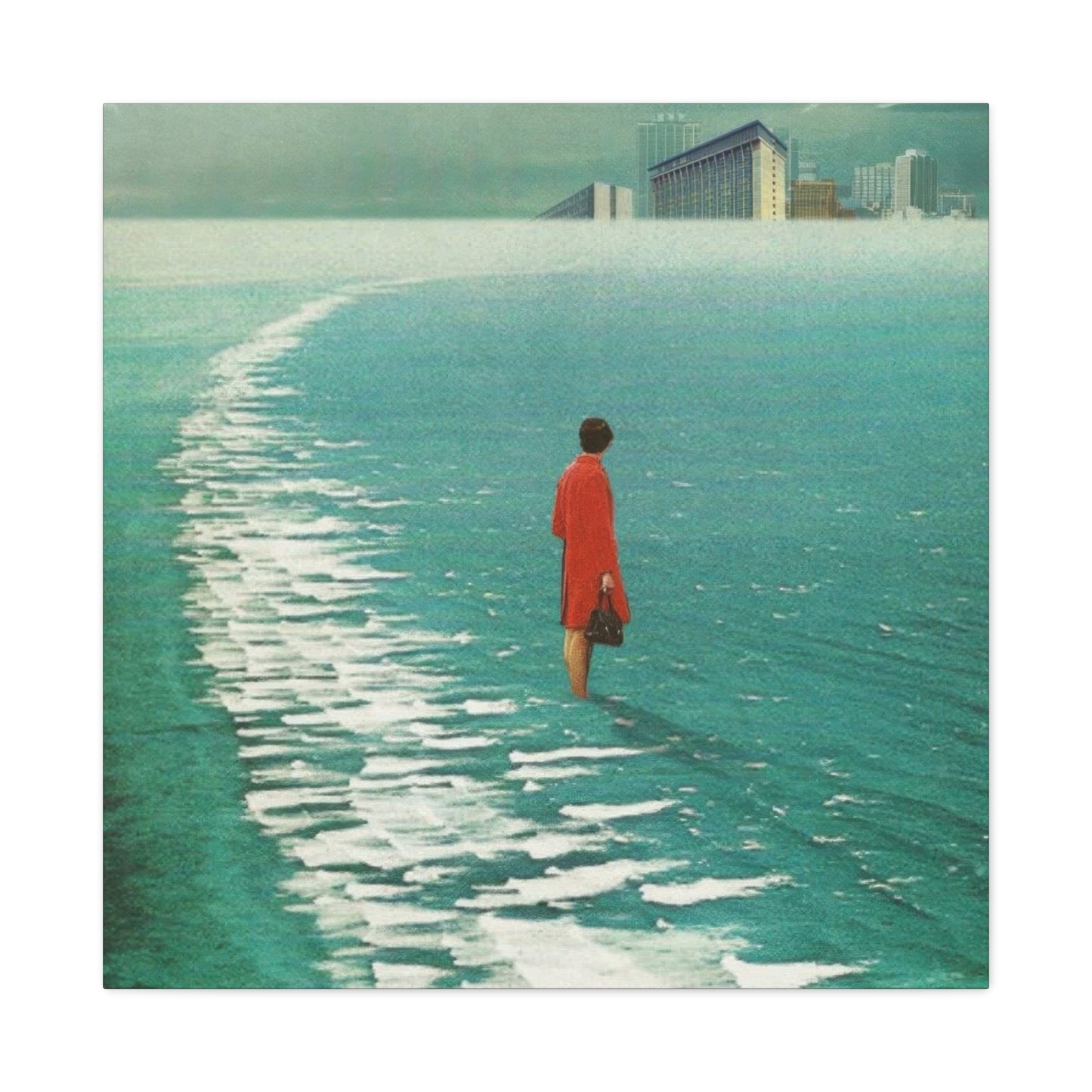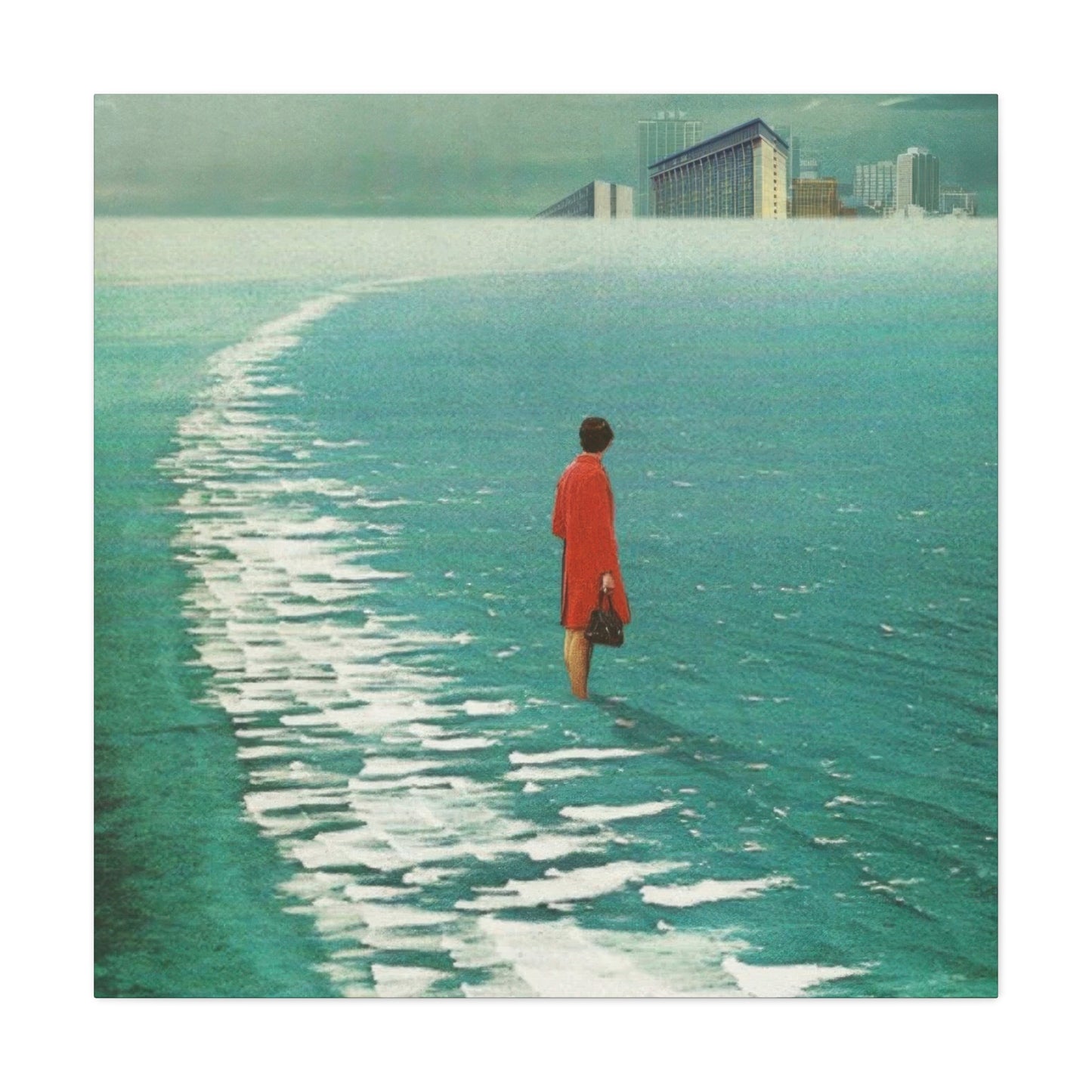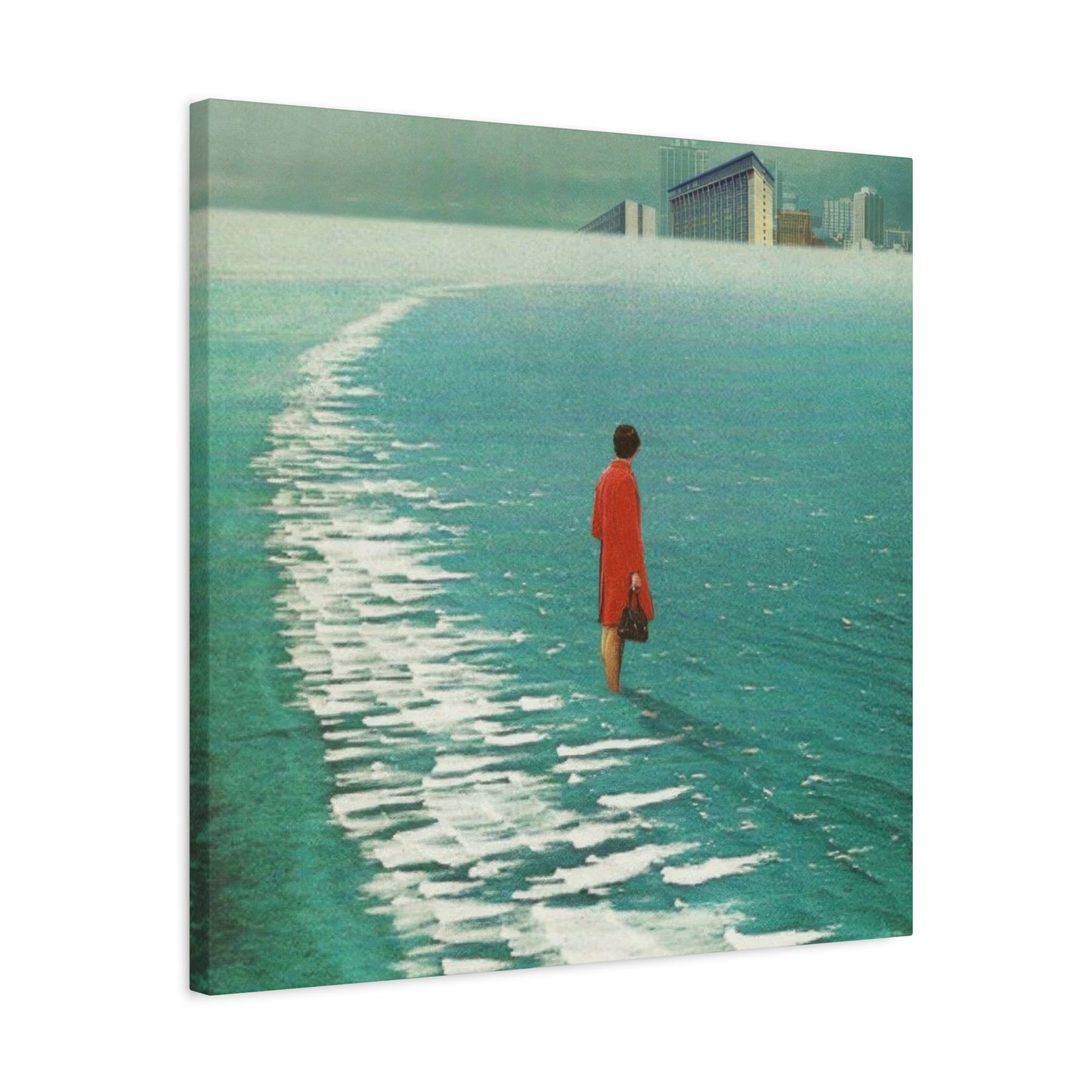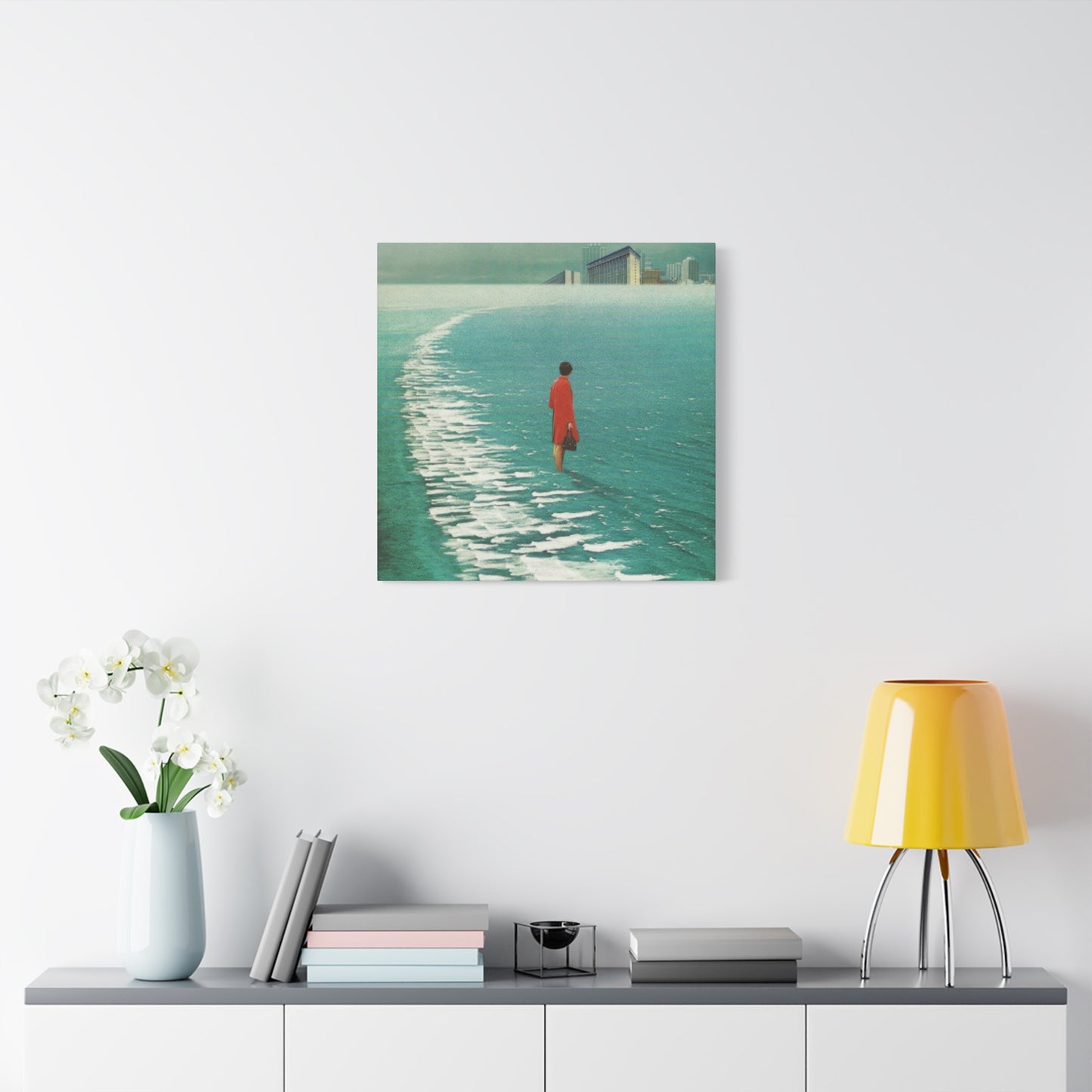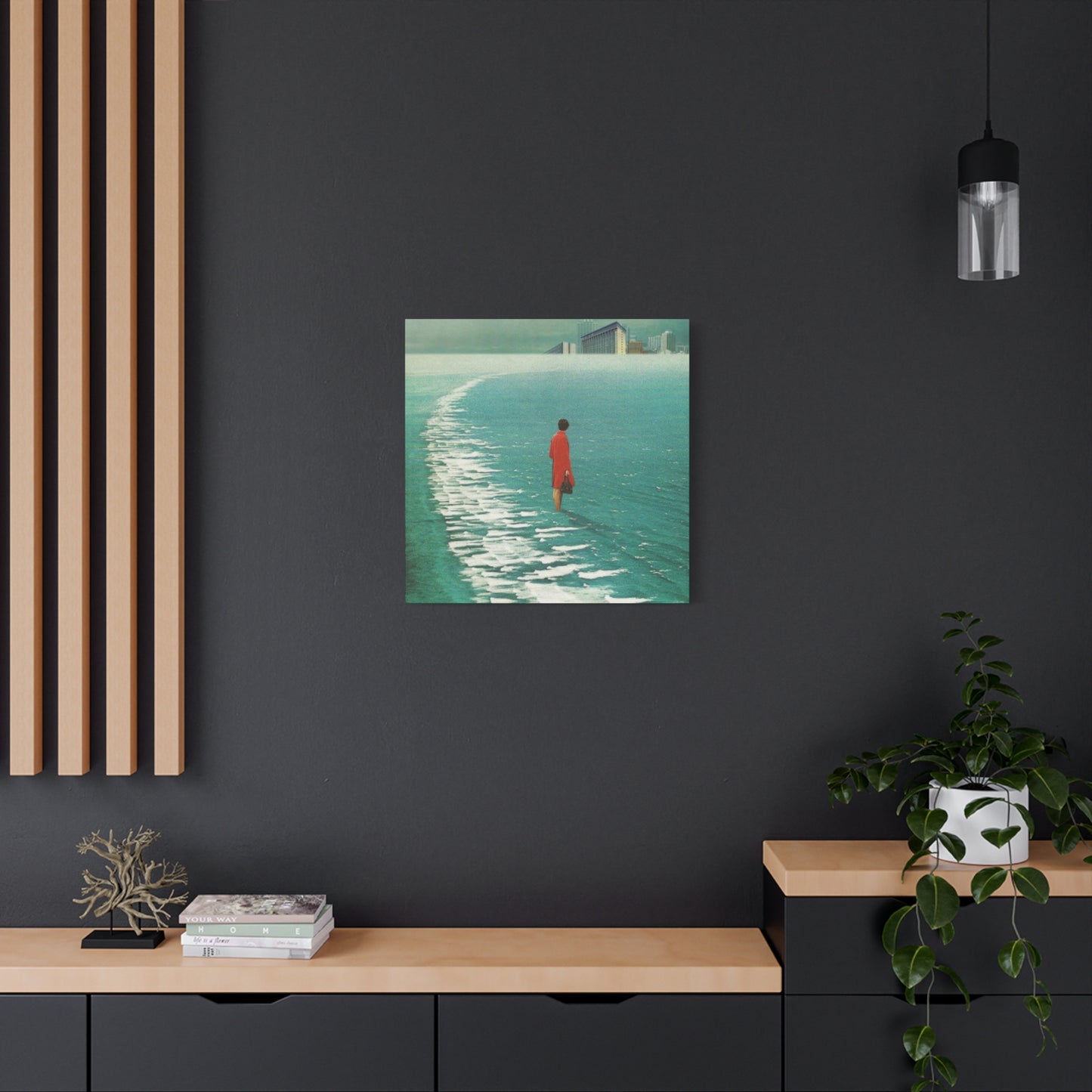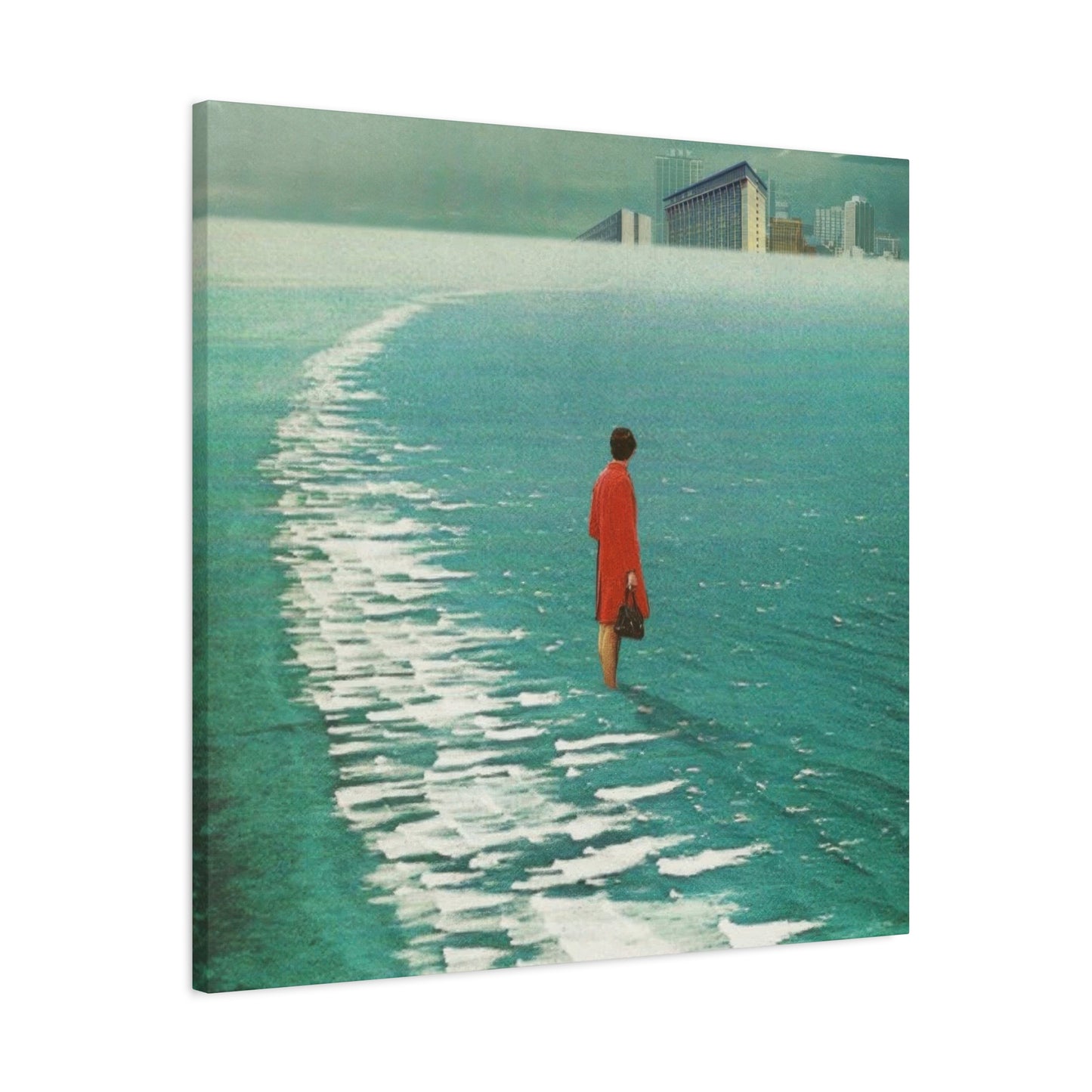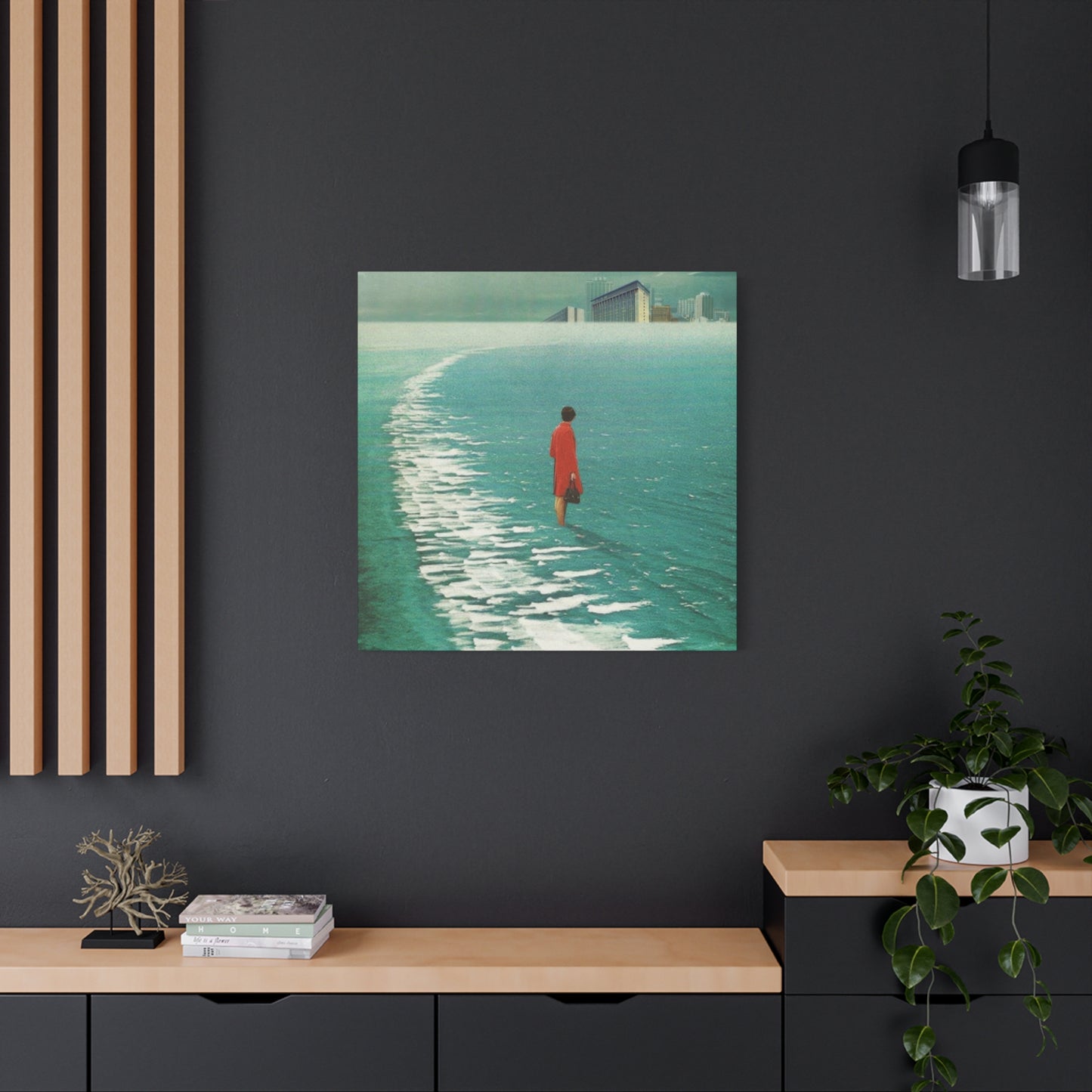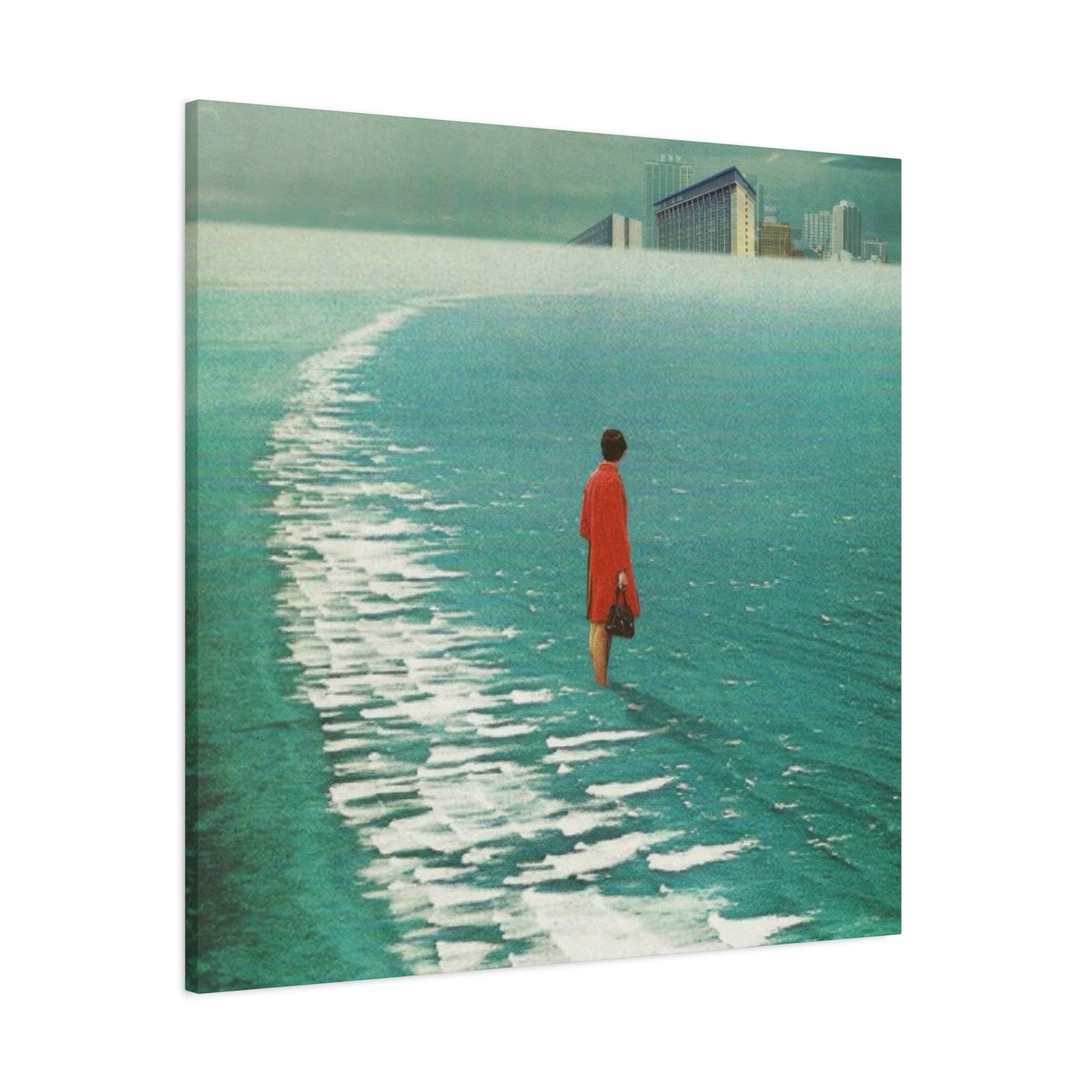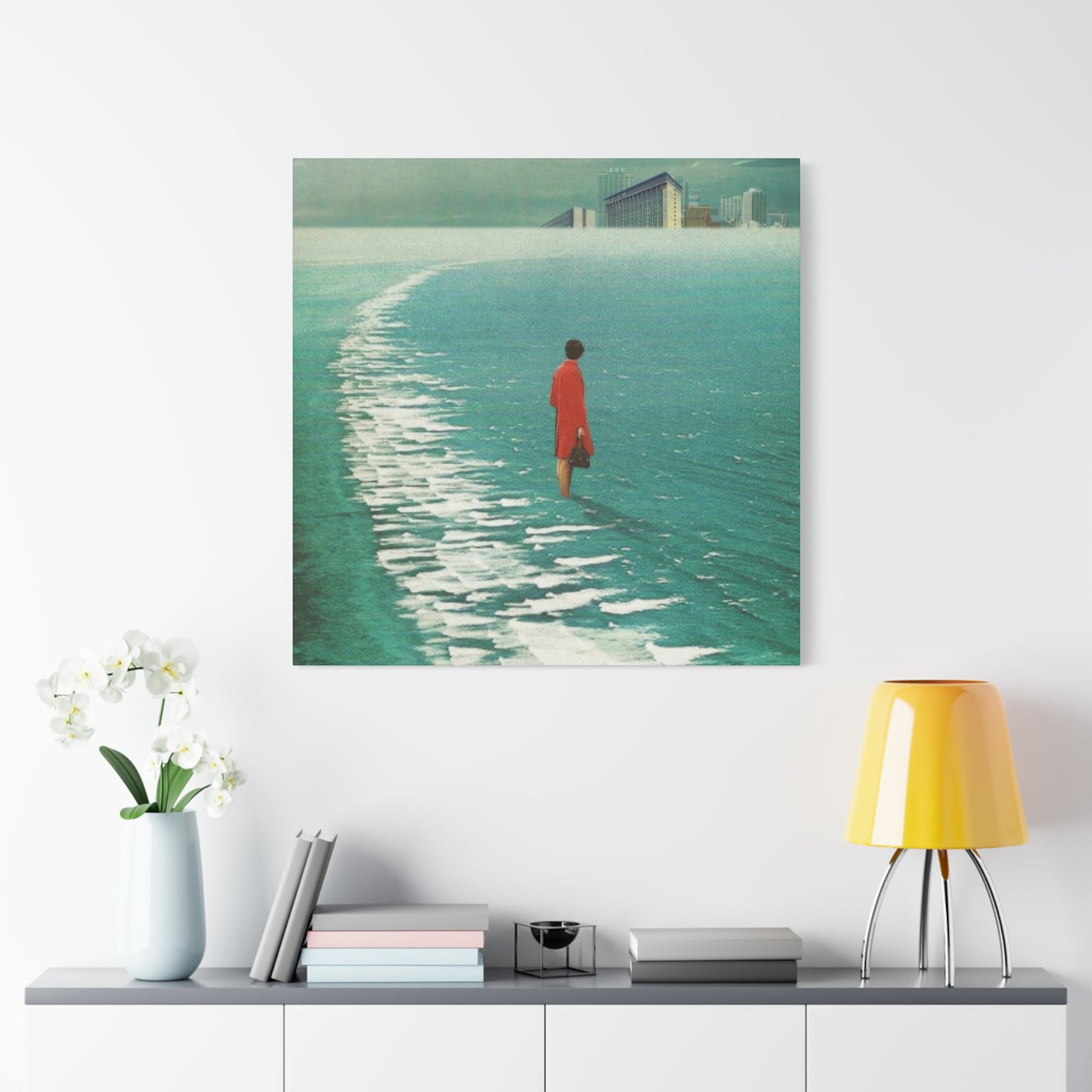The Art of City Reflection: Styling with Frank Moth’s Waiting for the Cities to Fade Out Wall Art
The contemporary art landscape has witnessed a remarkable evolution in recent years, with digital artists pushing boundaries and redefining what it means to create meaningful visual experiences. Among these innovative creators stands a distinctive voice whose work transcends traditional artistic conventions, merging vintage aesthetics with futuristic sensibilities to craft pieces that resonate deeply with modern audiences. This exploration delves into the intricate world of surrealist wall art that captures the imagination and speaks to the soul, examining how retro-futuristic compositions become powerful statements about human existence, urban environments, and the passage of time.
The Dreamlike Essence of Waiting for the Cities to Fade Out
Within the realm of contemporary surrealist artwork, certain pieces emerge that capture something ineffable about the human experience. These compositions transport viewers into alternate realities where familiar urban landscapes dissolve into dreamscapes, creating powerful visual narratives that linger in the mind long after first viewing. The concept of cities fading represents more than mere physical decay; it speaks to the ephemeral nature of civilization itself, the inevitable transformation of human achievements, and the bittersweet beauty found in impermanence.
This particular artistic vision manifests through carefully constructed layers of imagery that blend architectural elements with cosmic backdrops, solitary figures against vast horizons, and color palettes that evoke both warmth and melancholy. The dreamlike quality emerges not from abstract distortion but from the juxtaposition of realistic elements in impossible configurations, creating scenes that feel simultaneously familiar and alien. Viewers find themselves contemplating the relationship between humanity and the environments we construct, questioning whether our cities are monuments to permanence or temporary shelters against the vastness of time and space.
The emotional resonance of these works stems from their ability to tap into universal experiences of isolation, wonder, and nostalgia. Urban dwellers especially connect with imagery showing cities in states of transformation or decay, recognizing in these surreal landscapes the transient nature of metropolitan existence. The fading cities concept serves as a metaphor for personal memory, collective history, and the inevitable changes that sweep through societies and individual lives alike. Through this lens, wall art becomes more than decoration; it becomes a philosophical statement displayed in living spaces, constantly inviting reflection and introspection.
Each viewing reveals new details and meanings, as the layered construction of these pieces rewards sustained attention. The interplay between foreground subjects and background environments creates narrative possibilities that viewers complete through their own interpretations. Some perceive loneliness and loss, while others discover hope and renewal in the same imagery. This multiplicity of meaning characterizes truly effective surrealist art, which refuses simple interpretation while remaining emotionally accessible. The dreamlike essence captured in these works reflects the ambiguity of modern existence itself, where certainty dissolves into possibility and concrete realities blend with aspirational futures.
Exploring Nostalgia and Futurism in Frank Moth's Canvas Prints
The intersection of nostalgia and futurism creates a unique aesthetic territory that resonates powerfully with contemporary audiences. This artistic approach draws upon vintage visual languages from mid-century photography, advertising, and illustration while simultaneously projecting these elements into speculative futures or alternate presents. The resulting tension between past and future generates emotional complexity that makes these canvas prints particularly compelling for modern interior spaces.
Nostalgia in these works manifests through carefully selected source materials that evoke specific historical periods, particularly the mid-twentieth century era of space exploration, optimistic futurism, and analog photography. The grain of vintage film, the saturated colors of old print media, and the compositional styles of retro imagery all contribute to a sense of temporal displacement. Yet rather than simply recreating period aesthetics, these pieces remix historical visual elements into new configurations that speak to present concerns and future anxieties. This creates what might be called retrofuturism, where yesterday's vision of tomorrow becomes today's commentary on both past and present.
The futuristic dimension emerges through subject matter that suggests technological advancement, space exploration, and posthuman evolution. Astronauts appear in impossible contexts, celestial bodies dominate terrestrial landscapes, and architectural forms hint at civilizations beyond our current moment. However, the futurism presented maintains an analog warmth that distinguishes it from cold, digital science fiction aesthetics. This warmth comes partly from the vintage source materials but also from compositional choices that emphasize human-scale subjects and emotionally resonant scenarios rather than purely technological spectacle.
Canvas print medium itself contributes to the nostalgic dimension of these works. Unlike digital screens that emphasize ephemerality and endless reproducibility, physical canvas prints possess material presence and permanence. The texture of canvas, the depth of properly rendered colors, and the framed presentation all evoke traditional fine art while containing thoroughly contemporary content. This medium choice reinforces the temporal hybridity at the heart of the aesthetic, creating objects that exist simultaneously in multiple time periods.
Collectors and art enthusiasts drawn to these pieces often articulate feeling caught between past and future themselves, navigating rapid technological change while longing for perceived simplicities of earlier eras. The artwork mirrors this psychological state, offering visual representations of temporal complexity that validate mixed feelings about progress, change, and modernity. In home and office environments, these canvas prints serve as anchors for contemplation, reminding viewers that human experiences of time remain complex regardless of technological advancement.
The nostalgic elements never become mere sentimentality because they remain in productive tension with forward-looking imagery. Similarly, the futuristic components avoid sterile coldness through grounding in warmly human vintage aesthetics. This balance makes the work accessible to diverse audiences while maintaining artistic sophistication. Whether displayed in minimalist modern interiors or eclectic vintage-inspired spaces, these canvas prints bridge aesthetic divides and temporal categories, creating visual focal points that enhance rather than dominate their surroundings.
The Poetic Silence of Urban Decay in Digital Collage Art
Digital collage as an artistic medium has emerged as one of the most expressive forms for capturing contemporary experience, allowing artists to construct meaning through the strategic assembly of disparate visual elements. When applied to themes of urban decay, this technique achieves particular poetic power, creating silent narratives that speak volumes about civilization, entropy, and beauty emerging from deterioration. The quietness of these compositions contrasts sharply with the chaotic noise of actual urban environments, offering viewers contemplative spaces within which to process complex feelings about cities and their transformations.
Urban decay as subject matter carries rich symbolic weight in contemporary culture. Cities represent humanity's greatest collective achievements, concentrations of culture, commerce, and innovation that define civilizations. Yet these same structures inevitably age, deteriorate, and eventually fade, creating landscapes of abandonment that haunt the margins of thriving metropolises. Digital collage captures this duality by presenting decaying urban forms not as simple failures but as sites of continued meaning and strange beauty. Crumbling architecture becomes stage sets for surreal dramas, empty streets transform into contemplative spaces, and rusting infrastructure gains aesthetic dignity through careful compositional treatment.
The silence inherent in these static images amplifies their emotional impact. Without sound, viewers project their own internal narratives onto the scenes, hearing imagined wind through abandoned buildings, the echo of footsteps in empty plazas, or the absolute quiet of cities after humanity has departed. This silence also distinguishes the work from the sensory overload of actual urban experience, creating oases of calm that ironically emerge from imagery of collapse and decay. The poetic quality derives from this paradox: finding peace in imagery of dissolution, beauty in scenes of abandonment, and meaning in visual narratives of endings.
Digital collage techniques enable precise control over every element within the composition, allowing artists to construct perfectly balanced arrangements that would be impossible to capture through traditional photography alone. Multiple source images combine to create scenes that never existed but feel emotionally true, locations that inhabit the borderland between memory and imagination. Textures layer upon textures, creating visual richness that rewards close examination while maintaining coherent overall compositions when viewed from distance. This technical complexity remains largely invisible to casual viewers, who simply experience the emotional resonance of the finished work.
The urban elements chosen for these collages typically draw from mid-century architecture and infrastructure, periods when modernist optimism produced distinctive built environments now often endangered or already demolished. By incorporating these structures into surreal contexts, the work serves as unofficial memorial to vanished or vanishing urban landscapes, preserving their forms in artistic amber while simultaneously transforming them into elements of impossible dreamscapes. This preservation through transformation reflects how memory itself works, retaining impressions of places and times while inevitably altering them through subsequent experience and reflection.
Color palettes in these urban decay compositions tend toward muted tones, desaturated hues that suggest age and distance. When brighter colors appear, they often take the form of sunset skies, cosmic phenomena, or other natural elements contrasting with the gray concrete and steel of human construction. This interplay between warm celestial colors and cool architectural tones creates visual tension that reinforces thematic contrasts between nature and civilization, permanence and decay, hope and melancholy. The resulting images feel like memories from possible futures or alternate presents, familiar enough to recognize yet strange enough to unsettle and intrigue.
Frank Moth's Retro-Futuristic Aesthetic on Canvas
The development of a distinctive retro-futuristic aesthetic represents one of the most significant achievements in contemporary digital art, creating a visual language that speaks powerfully to audiences navigating the complexities of twenty-first century existence. This aesthetic draws inspiration from multiple historical sources while remaining thoroughly contemporary in execution and intention, resulting in artwork that transcends simple period recreation to achieve timeless relevance. Canvas presentation of this work adds materiality and presence that enhances the emotional impact of the imagery.
Retro-futurism as an aesthetic movement reflects sophisticated understanding of how past generations imagined futures that never arrived, and how those abandoned visions continue resonating in present consciousness. Mid-century space age aesthetics, with their optimistic faith in technological progress and human expansion beyond Earth, provide particularly rich source material. These historical visualizations of tomorrow carried assumptions about social organization, gender roles, and technological development that contemporary viewers recognize as charmingly naive or troublingly limited, yet the visual appeal of streamlined spacecraft, bubble helmets, and gleaming chrome surfaces remains undiminished.
The aesthetic approach visible in these canvas works selectively appropriates retro-futuristic elements while avoiding literal reproduction of vintage styles. Astronauts appear frequently but often in contexts far removed from realistic space exploration, becoming instead symbols of isolation, exploration, or humanity's cosmic insignificance. Spacecraft and satellites populate compositions as both technological artifacts and artistic forms, their curves and angles contributing to visual balance while carrying symbolic weight about human ambition and limitation. This selective appropriation creates work that references historical periods without being constrained by them, using the past as vocabulary for expressing present concerns.
Color treatment plays crucial roles in establishing the retro-futuristic atmosphere. Warm, saturated tones reminiscent of vintage color photography dominate many pieces, creating nostalgic emotional undertones even when subject matter suggests futuristic scenarios. These colors, slightly faded as if aged by time, contrast beautifully with the crispness of digital composition, creating temporal ambiguity that reinforces the retro-futuristic hybrid nature of the work. Blues, oranges, and muted reds appear frequently, evoking sunset skies, desert landscapes, and cosmic vistas while maintaining color harmony across diverse compositional elements.
Canvas as presentation medium amplifies the retro-futuristic aesthetic by adding physical substance to digital creations. The texture of canvas, the depth achieved through proper printing techniques, and the traditional framed presentation all evoke fine art traditions while containing thoroughly contemporary content. This medium choice reflects the temporal hybridity at the work's conceptual core, creating objects that bridge digital and analog, present and past, innovation and tradition. Collectors value canvas prints not just for visual appeal but for physical presence that transforms living and working spaces.
The aesthetic succeeds because it avoids becoming trapped in ironic distance or empty nostalgia. While clearly referencing historical visual languages, the work maintains emotional sincerity and thematic seriousness that invites genuine engagement rather than detached appreciation. Viewers respond not just to clever remixing of retro elements but to authentic artistic vision that uses these elements to construct meaningful statements about contemporary experience. The retro-futuristic aesthetic becomes vehicle for exploring timeless human concerns about purpose, connection, and meaning in contexts that feel both familiar and alien.
Symbolism and Emotion in Waiting for the Cities to Fade Out
Symbolic content and emotional resonance combine to create artwork that transcends mere visual appeal, offering viewers experiences that engage intellect and feeling simultaneously. The concept of cities fading carries multiple layers of symbolic meaning, from obvious commentary on urban decay and environmental crisis to subtler explorations of memory, impermanence, and the relationship between humanity and its creations. These symbolic dimensions unfold gradually through sustained engagement with the work, rewarding viewers who return repeatedly to pieces initially appreciated for aesthetic qualities alone.
Cities themselves function as primary symbols throughout the visual narrative, representing human civilization, collective achievement, and the complex social structures that define modern existence. When depicted in states of decay, abandonment, or gradual disappearance, these urban landscapes become memento mori for civilizations, reminders that even humanity's greatest constructions remain temporary against cosmic and geological timescales. This symbolism resonates particularly strongly with contemporary audiences witnessing actual urban decay in post-industrial cities while simultaneously confronting environmental challenges that threaten long-term urban sustainability.
Solitary figures appearing throughout these compositions carry rich symbolic weight, representing individual human consciousness navigating vast impersonal systems and environments. Often shown from behind or at distance, these figures become everyman characters with whom viewers identify regardless of specific demographic characteristics. Their isolation within vast urban or cosmic landscapes symbolizes modern experiences of alienation, disconnection, and the search for meaning within complex, often overwhelming social and technological systems. Yet these figures also embody resilience, curiosity, and the human capacity for wonder, standing witness to transformation and decay without succumbing to despair.
Cosmic elements, particularly moons, planets, and stars appearing in urban contexts, symbolize the vastness of space and time against which human endeavors unfold. These celestial bodies, often rendered at impossible scales or positions, remind viewers of Earth's place in larger cosmic contexts while creating surreal beauty through their juxtaposition with terrestrial structures. The symbolism operates on multiple levels: cosmic indifference to human concerns, the sublime beauty of natural phenomena contrasting with human constructions, and the aspirational dimension of space exploration representing human desire to transcend earthly limitations.
Emotional content in these works emerges organically from symbolic elements rather than being imposed through heavy-handed manipulation. The melancholy pervading many compositions arises naturally from imagery of decay, isolation, and vast spaces, yet never becomes overwhelming or depressive. Instead, the emotional tone might be described as contemplative melancholy, acknowledging loss and impermanence while finding beauty and meaning within these inevitable conditions. This emotional sophistication distinguishes serious artistic work from mere mood imagery, creating pieces that support rather than dictate viewer emotional experiences.
The fading cities concept specifically symbolizes transition and transformation rather than simple ending. Cities don't disappear instantaneously but gradually, leaving traces and memories that persist beyond physical structures. This symbolic understanding of fading as process rather than event creates space for hope within imagery that might otherwise seem purely pessimistic. The emotion evoked becomes bittersweet rather than simply sad, acknowledging what passes while remaining open to what emerges. This emotional and symbolic complexity makes the work suitable for long-term display in living spaces, where simplistic or manipulative emotional content would quickly become tiresome.
Art That Speaks of Time, Memory, and Transition
Temporal themes pervade contemporary artistic consciousness as individuals and societies grapple with rapid change, uncertain futures, and increasingly complex relationships with past and present. Artwork exploring time, memory, and transition offers viewers conceptual frameworks for processing their own temporal experiences, creating visual metaphors that make abstract concepts tangible and emotionally accessible. These themes manifest through imagery that layers different temporal moments, juxtaposes historical and futuristic elements, and creates scenes suggesting transition between states.
Time in these compositions operates non-linearly, with past, present, and future coexisting within single frames. Vintage photographic elements occupy the same visual space as futuristic or timeless cosmic phenomena, creating temporal collisions that mirror how memory actually functions in human consciousness. Remembered past, experienced present, and imagined future constantly interpenetrate in mental life, and artwork reflecting this complexity resonates deeply with viewers navigating their own temporal experiences. The compositions become visual analogues for consciousness itself, spaces where different temporal modes coexist and interact.
Memory as theme manifests through the nostalgic quality of vintage source materials and the dreamlike atmosphere of impossible scenes. The work evokes the feeling of memory more than specific memories, capturing the emotional texture of remembering, the way past experiences become abstracted and transformed through time. Urban landscapes function as memory palaces, architectural forms triggering associations and emotions that vary among viewers based on personal histories. The fading quality of cities mirrors how memories themselves fade, losing detail while retaining emotional significance and general impressions.
Transition appears throughout these works, suggested by figures poised between locations, cities in states of transformation, and skies that seem suspended between day and night, natural and supernatural. These transitional states reflect contemporary experience of living through profound changes in technology, climate, social organization, and cultural values. The artwork neither celebrates nor mourns these transitions but instead acknowledges them as fundamental conditions of existence, creating visual spaces where viewers can contemplate change without being overwhelmed by it. Transitional imagery validates feelings of uncertainty and displacement while suggesting these feelings themselves constitute meaningful responses to genuine conditions rather than personal failures.
The artistic treatment of these temporal themes avoids didacticism, trusting viewers to draw their own connections and conclusions. Rather than illustrating specific arguments about time, memory, or transition, the work creates evocative scenes that stimulate contemplation of these themes without dictating particular interpretations. This openness makes the artwork more durably engaging than pieces with more specific messages, as viewers discover new meanings and connections through repeated viewing over months and years.
Displayed in residential or professional environments, these temporally complex pieces function as persistent invitations to reflection, gentle reminders to consider longer temporal perspectives amid the urgency of daily concerns. In this sense, the artwork performs philosophical work, not through explicit argument but through creating sustained opportunities for contemplation. The pieces become companions in ongoing processes of self-understanding and meaning-making, their presence in living spaces supporting deeper engagement with questions about personal and collective existence.
A Journey Through Surreal Urban Landscapes
The surreal urban landscape has emerged as one of contemporary art's most compelling visual territories, offering endless possibilities for exploring the psychological, social, and philosophical dimensions of city life. These imaginary cityscapes combine recognizable urban elements with impossible juxtapositions and scale relationships, creating scenes that feel simultaneously familiar and alien. Through careful construction of these surreal environments, artists guide viewers on journeys through interior psychological landscapes as much as exterior architectural ones.
Urban landscapes in surrealist treatment become projection screens for contemporary anxieties, hopes, and contradictions about city life. Modern cities contain profound paradoxes: centers of opportunity that often generate isolation, monuments to human achievement that frequently dehumanize inhabitants, spaces of incredible cultural diversity that simultaneously enforce conformity. Surrealist urban imagery makes these contradictions visible by literalizing them through impossible architecture, solitary figures in crowded spaces, and other visual metaphors that capture the strangeness of actual urban experience.
The journey aspect of these compositions invites viewers to imaginatively inhabit the scenes, following suggested sight lines, paths, and spatial relationships through impossible environments. Empty streets lead toward surreal horizons, staircases ascend toward cosmic phenomena, and elevated vantage points offer perspectives on cities transformed by artistic vision into something beyond themselves. This sense of journey engages viewers actively rather than presenting them with static images to passively consume, creating participatory aesthetic experiences where imagination completes what the artwork suggests.
Architectural elements selected for these surreal landscapes typically draw from modernist and mid-century periods, when optimistic visions of urban futures produced distinctive built environments. Concrete brutalist structures, glass and steel towers, and geometric plaza designs all appear frequently, removed from their original contexts and recombined into new configurations. This selective architectural vocabulary creates visual coherence across diverse compositions while evoking specific historical moments in urban development. The choice to feature modernist architecture rather than contemporary styles adds to the temporal ambiguity of the work, making these surreal cities feel like alternate presents or abandoned futures rather than simple fantasies.
Scale manipulation constitutes one of the most powerful surrealist techniques deployed in these urban landscapes. Impossibly large celestial bodies loom over city skylines, tiny figures inhabit vast empty spaces, and architectural elements appear in unexpected proportions relative to each other. These scale shifts create dreamlike qualities while also commenting on actual experiences of cities, where individuals often feel dwarfed by immense structures and systems beyond their control or comprehension. The surreal treatment makes these real psychological experiences visible and concrete.
Color and light in these landscapes contribute to their otherworldly atmosphere while maintaining enough naturalism to keep scenes recognizable. Warm sunset tones bathe concrete and asphalt in golden light, softening harsh architectural forms and creating nostalgic atmospheres. Deep blue twilight skies suggest transitional moments between day and night, waking and dreaming, presence and absence. The careful management of light creates mood and emotional tone while defining spatial relationships within complex compositions, guiding viewer attention and suggesting narrative possibilities.
Blending Humanity and Technology in Frank Moth's Creations
The relationship between humanity and technology constitutes one of the defining concerns of contemporary existence, as individuals and societies navigate rapid technological change while questioning its impacts on human nature, social relationships, and environmental sustainability. Artistic explorations of this relationship offer crucial spaces for processing complex and often contradictory feelings about technology's role in human life. Through careful visual construction, certain digital artworks achieve nuanced treatment of human-technology relationships that avoids both uncritical technophilia and reactionary technophobia.
Human figures in these compositions typically appear in ambiguous relationships with technological elements, neither clearly dominating nor dominated by them. Astronauts, for instance, represent humans encased in protective technology that enables survival in hostile environments while also isolating them from direct sensory experience. This duality of technology as both enabler and barrier runs throughout the work, suggesting sophisticated understanding of how actual technologies function in human lives as tools that expand certain capacities while potentially diminishing others.
Technology in these pieces often takes retro-futuristic forms: analog equipment, mid-century spacecraft designs, visible mechanical components rather than sleek digital interfaces. This aesthetic choice emphasizes technology's materiality and comprehensibility, contrasting with contemporary digital technologies that increasingly operate as black boxes beyond user understanding or control. The visible, mechanical technology depicted in the artwork suggests a moment when human-technology relationships remained more transparent and perhaps more balanced, before digital systems achieved their current complexity and opacity.
The blending of humanity and technology manifests visually through composition rather than literal fusion of human and machine forms. Human figures occupy technological environments, interact with technological objects, or appear in contexts suggesting technological mediation of experience, but typically retain clear human form rather than becoming cyborgs or post-human entities. This restraint allows exploration of human-technology relationships while maintaining human subjects as recognizably human, enabling viewer identification and emotional connection.
Cosmic and natural elements appearing alongside technological imagery create triangular relationships among humanity, technology, and nature, complicating simple binaries between natural and artificial. Technological forms enable human access to natural wonders like space while also mediating and potentially distancing direct experience of these phenomena. The artwork doesn't resolve these tensions but instead holds them in productive suspension, creating visual fields where different value systems and experiential modes coexist without false synthesis.
The emotional tone surrounding technology in these works tends toward ambivalence rather than celebration or condemnation. There's wonder at technological achievement and beauty in technological forms, but also acknowledgment of isolation, alienation, and loss that can accompany technological mediation of experience. This emotional complexity reflects actual contemporary relationships with technology, where most people simultaneously depend on and feel overwhelmed by technological systems, appreciate technological benefits while mourning what technology displaces or destroys.
The Emotional Power of Collage in Contemporary Art
Collage as artistic medium possesses unique emotional potentials that distinguish it from other visual art forms, particularly in digital execution where technical possibilities expand dramatically. The fundamental collage logic of combining disparate elements to create new meanings generates emotional complexity through juxtaposition, layering, and recombination of culturally resonant imagery. Understanding collage's emotional power requires examining both its technical operations and its psychological and cultural effects on viewers.
The juxtaposition essential to collage creates emotional effects through productive tension between combined elements. When vintage photographs meet cosmic phenomena, urban architecture encounters natural landscapes, or human figures appear in impossible contexts, viewers experience cognitive and emotional responses to these unexpected combinations. The surprise of seeing familiar elements in unfamiliar relationships generates engagement and curiosity, drawing viewers into sustained looking that reveals additional layers and meanings. This initial surprise deepens into more complex emotional responses as viewers process the implications and resonances of specific juxtapositions.
Layering in digital collage enables creation of visual depth that mirrors emotional complexity. Multiple semi-transparent image layers can create ghostly, dreamlike effects suggesting memory, loss, or alternate possibilities. Carefully layered textures add visual richness that rewards close attention while maintaining compositional clarity at viewing distance. This technical layering creates works that reveal themselves gradually, offering different experiences depending on viewing distance, duration, and viewer state of mind. The emotional response to such work evolves over time rather than being immediately exhausted.
Cultural memory embedded in source imagery contributes significantly to collage's emotional impact. Vintage photographs, for instance, carry associations with specific historical periods, social values, aesthetic conventions, and emotional tones. When these culturally loaded images enter new compositional contexts, they bring their associated meanings and feelings along, creating rich semantic and emotional fields within which new meanings emerge. Viewers respond not just to what images explicitly depict but to everything they culturally represent and personally evoke.
The fragmentary nature of collage resonates with contemporary experiences of information overload, cultural fragmentation, and identity construction from diverse sources. In an era when individuals constantly assemble meaning from disparate media fragments, collage's logic of meaningful combination from diverse elements feels particularly relevant and emotionally authentic. The artwork mirrors viewers' own practices of making sense from overwhelming information flows, creating solidarity between artwork and audience through shared modes of meaning-making.
Digital collage specifically enables precision impossible in traditional cut-and-paste techniques while maintaining collage's essential character. Seamless blending of elements creates surreal scenes that appear photographically unified despite impossibility, generating tension between visual coherence and conceptual impossibility that drives emotional and intellectual engagement. The digital tools allow artists to realize visions with exactitude while retaining the conceptual disruption and productive tension that make collage powerful.
Emotional accessibility of these collage works, despite their surreal content and sophisticated construction, makes them effective across diverse audiences. The imagery remains recognizable and emotionally evocative even when juxtapositions create disorienting effects. This combination of accessibility and sophistication enables the work to function successfully in various contexts from private residences to commercial spaces, engaging casual viewers while offering depth for sustained engagement.
Storytelling Through Visual Layers and Digital Textures
Contemporary digital art has elevated visual storytelling to new levels of sophistication through strategic use of layering and texture, creating narratives that unfold non-linearly across spatial and temporal dimensions. Unlike traditional linear narratives that progress through sequential events, visual storytelling through layered compositions presents multiple narrative elements simultaneously, allowing viewers to construct their own narrative understandings based on which elements they notice and how they relate them. This open-ended narrative structure respects viewer intelligence and agency while creating durably engaging artwork.
Visual layers in digital composition can function as temporal layers, with different elements suggesting different moments in time coexisting within single frames. Background elements might suggest distant past or far future, middle ground elements establish present scenarios, and foreground details provide immediate focal points. Viewers' eyes move through these layers, constructing temporal narratives that may differ substantially among individuals based on which elements they emphasize and how they interpret relationships among layers. This multiplicity of potential narratives makes the work richer than pieces with singular, predetermined meanings.
Texture in digital art serves both aesthetic and narrative functions, adding visual interest while contributing to storytelling through associations and implications. Grain suggesting vintage photography instantly conveys temporal distance and nostalgia, smooth gradients suggest cosmic or futuristic elements, and rough concrete textures evoke urban environments and industrial decay. These textural elements don't just create visual variety but carry narrative information, contextualizing other compositional elements and contributing to overall storytelling.
The narrative content in these works tends toward open-ended scenarios rather than specific plot developments. A solitary figure contemplating a vast landscape suggests exploration, isolation, contemplation, or transition without specifying exact circumstances or outcomes. This narrative openness invites viewer participation in completing stories suggested but not determined by compositions. Different viewers bring different experiences and associations to artworks, generating diverse narrative interpretations that enrich rather than dilute meaning. The pieces become collaborative storytelling ventures between artist and audience.
Symbolic narrative elements recur across multiple works, creating broader narrative continuities while allowing individual pieces to stand alone. Astronauts as recurring figures, for instance, develop symbolic significance beyond any single composition, becoming representatives of exploration, isolation, and humanity's cosmic situation. Cities in various states of decay or transformation form another recurring narrative element, suggesting ongoing processes rather than isolated moments. These recurring symbols create loose narrative threads connecting otherwise independent works.
Digital techniques enable narrative construction impossible in traditional media, allowing seamless integration of elements from radically different sources and contexts. Photographic realism can be maintained while creating impossible scenarios, generating productive tension between believability and impossibility that drives narrative engagement. Viewers' minds work to reconcile the photographically convincing with the logically impossible, an effort that generates both cognitive engagement and emotional response.
The storytelling achieved through these visual means ultimately serves emotional and philosophical purposes rather than simple entertainment. The narratives suggested by layered compositions and textured surfaces invite reflection on larger themes of existence, meaning, relationship, and change. Story becomes vehicle for exploring ideas and emotions rather than end in itself, creating artwork that engages viewers intellectually and emotionally while remaining visually compelling.
A Modern Reflection on Vanishing Cities and Human Connection
Urban transformation and the anxiety of disappearance haunt contemporary consciousness as cities undergo radical changes driven by economic forces, environmental pressures, and technological disruption. The concept of vanishing cities operates as powerful metaphor for broader experiences of loss, change, and the dissolution of familiar structures and certainties. Artistic engagement with these themes provides necessary spaces for processing complex emotions about urban change while exploring questions about human connection in increasingly mediated and transient environments.
Cities vanish in multiple ways in contemporary reality: through economic collapse that leaves formerly thriving areas abandoned, through gentrification that displaces longstanding communities and erases cultural histories, through climate change that threatens coastal cities and increases extreme weather events, and through technological transformation that fundamentally alters urban social relationships and spatial practices. Artwork engaging these themes doesn't typically specify which type of vanishing it depicts, instead creating general metaphors applicable across these various modes of urban dissolution.
The human connection dimension of vanishing cities addresses how urban transformation affects relationships and community. As cities change, social networks disperse, familiar gathering places disappear, and the social fabric that bound communities together often unravels. The solitary figures appearing throughout these compositions can be read as symbols of this relational dissolution, individuals isolated within or after urban collapse. Yet these figures also suggest resilience and the continued human need for connection even amid dissolution and transformation.
Visual treatment of vanishing cities typically avoids apocalyptic imagery or disaster scenarios, instead presenting decay as gradual process that reveals unexpected beauty. This aesthetic choice reflects mature understanding of how cities actually change: not through sudden catastrophe but through incremental transformations that accumulate over years and decades. Empty streets, crumbling facades, and abandoned structures appear bathed in beautiful light, suggesting that endings and dissolutions carry their own aesthetic and emotional validity rather than being purely negative experiences to be avoided or denied.
The reflection on human connection in contexts of urban vanishing raises questions about what sustains relationships and community. If physical places disappear, do the connections they housed disappear as well? Can community persist beyond specific locations? How do relationships adapt to urban transformation? The artwork doesn't answer these questions but creates visual contexts within which viewers contemplate them, making abstract concerns concrete through evocative imagery.
Modern urban experience involves constant negotiation between connection and isolation, with cities paradoxically serving as sites of intense human proximity that often generate profound loneliness. The vanishing cities imagery makes this paradox visible, showing urban spaces as simultaneously sites of potential connection and actual isolation. The ambiguity in these images mirrors the ambiguity of actual urban experience, where the same spaces and structures can facilitate or impede human connection depending on countless variables.
Environmental dimensions of urban vanishing receive subtle treatment through compositional choices emphasizing nature's persistence and power relative to human constructions. Cosmic phenomena, natural light, and vast skies all suggest contexts larger than human concerns, within which cities appear as temporary and fragile. This environmental perspective doesn't typically take the form of explicit ecological messaging but rather emerges through visual relationships that position urban environments within larger natural and cosmic contexts.
The Beauty of Melancholy in Retro-Inspired Wall Décor
Melancholy as emotional tone occupies complex position in contemporary culture, often dismissed as merely depressive yet recognized by many as containing valuable dimensions of experience. The beauty of melancholy lies in its acknowledgment of loss, impermanence, and limitation without descending into either despair or denial. Retro-inspired visual art particularly lends itself to melancholic beauty through its temporal displacement, vintage aesthetics, and themes of nostalgia and change. Understanding why melancholic wall décor appeals to contemporary audiences requires examining both the emotion itself and its aesthetic expression.
Melancholy differs from depression in its contemplative quality and aesthetic dimension. Where depression typically involves emotional numbness or overwhelming pain, melancholy maintains capacity for finding beauty and meaning within sad experiences. The melancholic sensibility recognizes that loss and limitation are intrinsic to existence rather than aberrations to be eliminated, and finds within this recognition a certain dignity and depth. Retro imagery naturally carries melancholic undertones through its documentation of vanished times and transformed circumstances, evoking both pleasure in remembering and pain in acknowledging what has passed.
The beauty in melancholic imagery arises from its emotional honesty and refusal of false optimism. Contemporary culture often demands relentless positivity that many find exhausting and alienating. Melancholic art offers respite from this pressure, creating spaces where sadness and loss receive acknowledgment as valid responses to real conditions. The aesthetic treatment makes these difficult emotions bearable and even pleasurable through compositional beauty, color harmony, and evocative imagery that elevates raw sadness into contemplative melancholy.
Retro-inspired aesthetics amplify melancholic potential through their temporal displacement and nostalgic associations. Vintage color palettes, aged textures, and mid-century visual languages all evoke times that can only be accessed through memory and representation. This inaccessibility generates gentle sadness that intensifies appreciation for captured moments and preserved images. The retro elements function as memento of time's passage and change's inevitability, making abstract temporal concepts emotionally tangible.
Wall décor featuring melancholic imagery serves important psychological functions in living spaces. Rather than simply decorating, these pieces create ongoing presences that validate complex emotional experiences and support contemplative mental states. In bedrooms, melancholic imagery might facilitate introspection before sleep or upon waking. In living areas, such pieces provide counterpoints to the distracting stimulation of contemporary media environments. In professional spaces, melancholic art can ground and center consciousness amid workday demands and pressures.
The appeal of melancholic aesthetics connects to broader contemporary interest in mindfulness, introspection, and emotional authenticity. As wellness discourse emphasizes presence and acceptance of full emotional ranges, melancholic art finds growing audiences who appreciate its permission to feel sadness without judgment or rush toward resolution. The pieces become companions in practicing emotional awareness and acceptance, their persistent presence supporting viewer development of more nuanced relationships with difficult feelings.
Conclusion
Frank Moth’s “Waiting for the Cities to Fade Out” Wall Art offers a profound exploration of urban reflection, solitude, and the quiet beauty found within the fleeting moments of city life. This artwork captures the interplay between human presence, architectural structures, and natural light, transforming interior spaces into contemplative environments that balance aesthetic sophistication with emotional resonance. By incorporating this piece into contemporary interiors, homeowners and designers can cultivate spaces that evoke introspection, elegance, and subtle narrative depth, turning walls into immersive canvases that both visually captivate and intellectually engage.
At the heart of Moth’s Waiting for the Cities to Fade Out is the masterful use of reflection and perspective. Through precise composition and delicate attention to light, shadow, and urban details, the artwork conveys a serene and almost meditative interpretation of cityscapes. Reflections in windows, water, or glass surfaces create layered visual experiences that allow the viewer to see both the physical city and its ephemeral, transient qualities. The muted tones, carefully controlled highlights, and thoughtful contrasts contribute to a sophisticated palette that harmonizes with contemporary, minimalist, or industrial interiors. This balance between realism and subtle abstraction ensures that the artwork is both visually striking and emotionally compelling, inviting prolonged engagement and reflection.
From an interior design perspective, Moth’s work offers versatility and transformative potential. Large-format canvases serve as dramatic focal points in living rooms, studies, or private galleries, anchoring the space with contemplative elegance. Smaller formats or paired installations can create gallery-style arrangements that guide the viewer through a narrative of urban exploration, reflection, and quiet observation. The subdued color schemes and architectural focus complement a wide range of décor styles, including modern, loft, Scandinavian, and eclectic interiors. This adaptability allows homeowners to integrate the artwork seamlessly while establishing a strong thematic identity rooted in sophistication, urban narrative, and reflective calm.
Lighting is pivotal in enhancing the impact of Waiting for the Cities to Fade Out. Ambient illumination accentuates subtle tonal shifts and highlights reflective surfaces, while directional or accent lighting draws attention to specific architectural or compositional elements. The interplay between light and shadow enhances depth, dimensionality, and atmospheric presence, making the artwork appear dynamic and immersive. By carefully positioning light sources, viewers can experience evolving nuances throughout the day, creating an environment where the artwork continually engages and inspires.
Emotionally, the piece resonates because it evokes themes of solitude, introspection, and quiet appreciation of urban life. The reflective surfaces and contemplative composition encourage viewers to pause, observe, and engage with both the external city and internal perception. This duality allows interiors to become not only visually elegant but also psychologically enriching, offering spaces where creativity, focus, and contemplation are nurtured. The artwork’s ability to balance emotional depth with aesthetic sophistication ensures a lasting impression of both serenity and intellectual engagement.
Artistically, Frank Moth demonstrates mastery in perspective, composition, and tonal control. The use of reflection as a central device transforms ordinary cityscapes into layered narratives of observation, time, and urban rhythm. Subtle gradations of light and shadow, meticulous attention to detail, and thoughtful abstraction create a harmonious balance between structure and fluidity. This approach allows viewers to appreciate both the technical precision and the emotional resonance of the piece, ensuring it remains compelling across time and context.
Ultimately, Waiting for the Cities to Fade Out Wall Art exemplifies how reflective, urban-inspired artwork can elevate interiors, transforming walls into focal points of sophistication, narrative depth, and contemplative beauty. The piece turns ordinary spaces into immersive visual experiences, combining emotional resonance with aesthetic refinement, and reinforcing a modern, cultured approach to interior design.
In essence, this artwork is more than décor—it is an exploration of urban quietude, perception, and artistic mastery. By incorporating Frank Moth’s Waiting for the Cities to Fade Out Wall Art into contemporary interiors, homeowners and designers create spaces that are visually arresting, emotionally rich, and intellectually stimulating. Each canvas introduces reflection, depth, and urban elegance, ensuring interiors reflect both aesthetic sophistication and narrative depth, leaving a lasting impression of artistry, contemplation, and city-inspired inspiration.

















